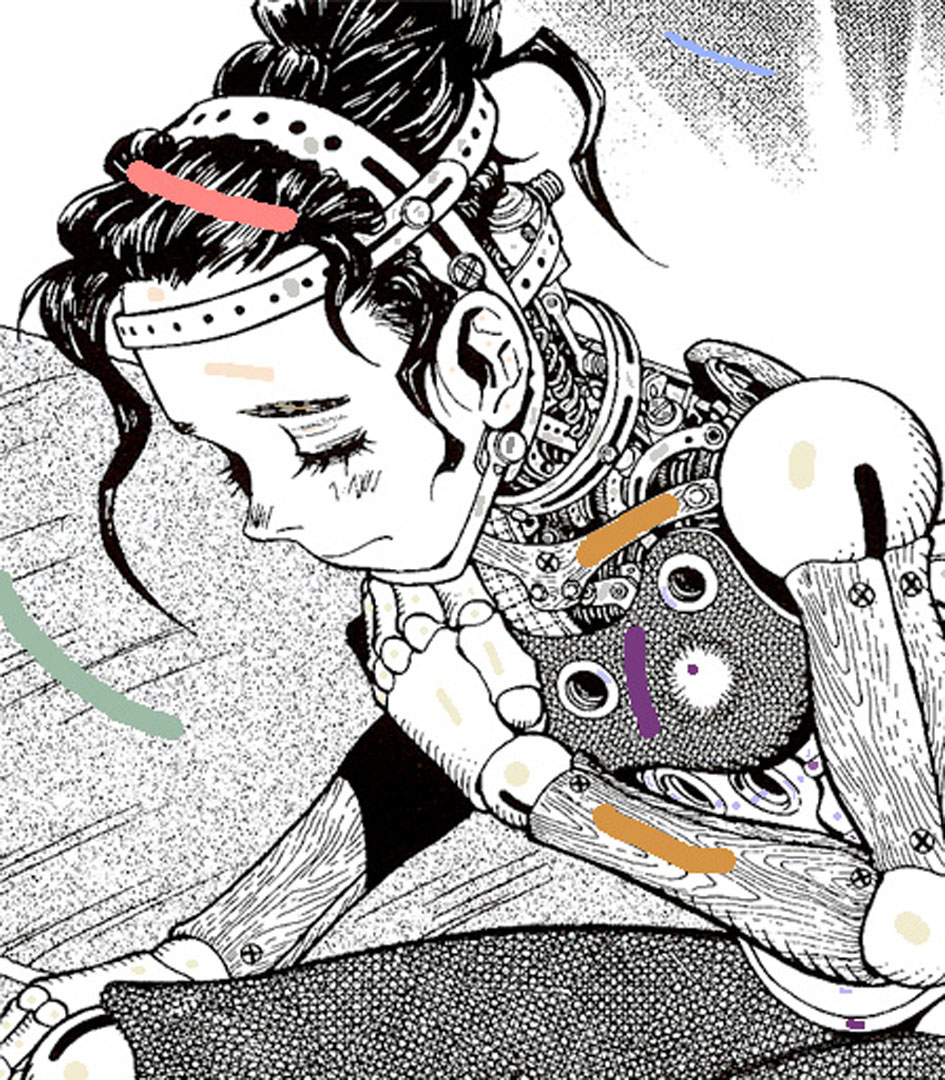“Manga colorization” by Qu, Wong and Heng
Conference:
Type(s):
Title:
- Manga colorization
Presenter(s)/Author(s):
Abstract:
This paper proposes a novel colorization technique that propagates color over regions exhibiting pattern-continuity as well as intensity-continuity. The proposed method works effectively on colorizing black-and-white manga which contains intensive amount of strokes, hatching, halftoning and screening. Such fine details and discontinuities in intensity introduce many difficulties to intensity-based colorization methods. Once the user scribbles on the drawing, a local, statistical based pattern feature obtained with Gabor wavelet filters is applied to measure the pattern-continuity. The boundary is then propagated by the level set method that monitors the pattern-continuity. Regions with open boundaries or multiple disjointed regions with similar patterns can be sensibly segmented by a single scribble. With the segmented regions, various colorization techniques can be applied to replace colors, colorize with stroke preservation, or even convert pattern to shading. Several results are shown to demonstrate the effectiveness and convenience of the proposed method.
References:
1. Burns, G. Colorization. museum of broadcast communications: Encyclopedia of television. http://www.museum.tv/archives/etv/index.html.Google Scholar
2. Galun, M., Sharon, E., Basri, R., and Brandt, A. 2003. Texture segmentation by multiscale aggregation of filter responses and shape elements. In Proceedings of IEEE International Conference on Computer Vision, 716–723. Google ScholarDigital Library
3. Hertzmann, A., Jacobs, C. E., Oliver, N., Curless, B., and Salesin, D. H. 2001. Image analogies. In Proceedings of SIGGRAPH 2001, Computer Graphics Proceedings, Annual Conference Series, 327–340. Google ScholarDigital Library
4. Hofmann, T., Puzicha, J., and Buhmann, J. M. 1998. Unsupervised texture segmentation in a deterministic annealing framework. IEEE Transactions on Pattern Analysis and Machine Intelligence 20, 8, 803–818. Google ScholarDigital Library
5. Irony, R., Cohen-Or, D., and Lischinski, D. 2005. Colorization by example. In Proc. of Eurographics Symposium on Rendering 2005, 201–210. Google ScholarDigital Library
6. Julesz, B. 1981. Textons, the elements of texture perception, and their interactions. Nature 290, 91–97.Google ScholarCross Ref
7. Levin, A., Lischinski, D., and Weiss, Y. 2004. Colorization using optimization. ACM Transactions on Graphics, 3, 689–694. Google ScholarDigital Library
8. Manjunath, B. S., and Ma, W. Y. 1996. Texture features for browsing and retrieval of image data. IEEE Transactions on Pattern Analysis and Machine Intelligence 18, 8, 837–842. Google ScholarDigital Library
9. Markle, W., and Hunt, B. 1987. Coloring a black and white signal using motion detection. Canadian patent no. 1291260 (December).Google Scholar
10. Neuraltek. 2003. Blackmagic photo colorization software. http://www.timebrush.com/blackmagic.Google Scholar
11. Osher, S., and Sethian, J. A. 1988. Fronts propagating with curvature-dependent speed: algorithms based on Hamilton-Jacobi formulations. Journal of Computational Physics 79, 1, 12–49. Google ScholarDigital Library
12. Ostromoukhov, V., and Hersh, R. D. 1995. Artistic screening. In Proceedings of SIGGRAPH’95, 219–228. Google ScholarDigital Library
13. Paragios, N., and Deriche, R. 1999. Geodesic active regions for supervised texture segmentation. In Proceedings of International Conference on Computer Vision, 926–932. Google ScholarDigital Library
14. Reinhard, E., Ashikhmin, M., Gooch, B., and Shirley, P. 2001. Color transfer between images. IEEE Transactions on Computer Graphics and Applications 21, 5, 34–41. Google ScholarDigital Library
15. Sethian, J. A. 1996. Level Set Methods. Cambridge University Press.Google Scholar
16. Sethian, J. A. 1999. Level Set Methods and Fast Marching Methods: Evolving Interfaces in Computational Geometry, Fluid Mechanics, Computer Vision, and Materials Science. Cambridge University Press.Google Scholar
17. Silberg, J. 1998. The pleasantville post production team that focussed on the absence of color. Cinesite Press Article. http://www.Cinesite.com/core/PRESS/articles/1998/10_00_98-team.html.Google Scholar
18. Sykora, D., Burianek, J., and Jirizara. 2004. Unsupervised colorization of black-and-white cartoons. In Proc. of Third International Symposium on Non Photorealistic Animation and Rendering, 121–128. Google ScholarDigital Library
19. Varma, M., and Zisserman, A. 2003. Texture classification: Are filter banks necessary? In Proceedings of the IEEE Conference on Computer Vision and Pattern Recognition, 691–698.Google Scholar
20. Weldon, T. P., Higgins, W. E., and Dunn, D. F. 1996. Efficient Gabor filter design for texture segmentation. Pattern Recognition 29, 12, 2005–2015.Google ScholarCross Ref
21. Welsh, T., Ashikhmin, M., and Mueller, K. 2002. Transferring color to grayscale images. In Proceedings of SIGGRAPH 2002, Computer Graphics Proceedings, Annual Conference Series, 277–280. Google ScholarDigital Library




